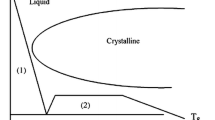Abstract
Polymer microfluidic devices are used for many purposes such as microarrays and biochips. The key tool for manufacturing these chips in bulk is an appropriate mold. However, the popular material for making molds is nickel or nickel alloys, which have low stiffness and wear out easily. Zr-based metallic glass is a promising material for micro- or nanomolds because it has good mechanical properties and can be easily formed with high precision. In this paper, Zr-based metallic glass is proposed for use as micromold insert to make poly-(methyl methacrylate) (PMMA) microfluidic devices. Our experiments show that they have good feature integrity and replication quality. Microchannels we fabricated using these replicas did not leak and had good flow performance. Zr-based metallic glass can greatly ease the manufacture of plastic microfluidic devices for research and commercial applications.





Similar content being viewed by others
References
M. Agarwal, R.A. Gunasekaran, P. Coane, K. Varahramyan, Scum-free patterning of SU-8 resist for electroforming applications. J. Micromech. Microeng. 15(1), 130–135 (2005)
L. Brown, T. Koerner, J.H. Horton, R.D. Oleschuk, Fabrication and characterization of poly(methylmethacrylate) microfluidic devices bonded using surface modifications and solvents. Lab Chip 6(1), 66–73 (2006)
C.D. Chin, V. Linder, S.K. Sia, Commercialization of microfluidic point-of-care diagnostic devices. Lab Chip 12(12), 2118–2134 (2012)
D.J. Guckenberger, T.E. de Groot, A.M.D. Wan, D.J. Beebe, E.W.K. Young, Micromilling: A method for ultra-rapid prototyping of plastic microfluidic devices. Lab Chip 15(11), 2364–2378 (2015)
E.M. Hamad, S.E.R. Bilatto, N.Y. Adly, D.S. Correa, B. Wolfrum, M.J. Schoning, A. Offenhausser, A. Yakushenko, Inkjet printing of UV-curable adhesive and dielectric inks for microfluidic devices. Lab Chip 16(1), 70–74 (2016)
T. Katoh, R. Tokuno, Y. Zhang, M. Abe, K. Akita, M. Akamatsu, Micro injection molding for mass production using LIGA mold inserts. Microsyst. Technol. 14(9–11), 1507–1514 (2008)
G. Kumar, A. Desai, J. Schroers, Bulk metallic glass: The smaller the better. Adv. Mater. 23(4), 461–476 (2011)
T.-Y. Lin, T. Do, P. Kwon, P.B. Lillehoj, 3D printed metal molds for hot embossing plastic microfluidic devices. Lab Chip 17(2), 241–247 (2017)
S. Moon, N. Lee, S. Kang, Fabrication of a microlens array using micro-compression molding with an electroformed mold insert. J. Micromech. Microeng. 13(1), 98–103 (2003)
C. Schuh, T. Hufnagel, U. Ramamurty, Mechanical behavior of amorphous alloys. Acta Mater. 55(12), 4067–4109 (2007)
W.H. Wang, The elastic properties, elastic models and elastic perspectives of metallic glasses. Prog. Mater. Sci. 57(3), 487–656 (2012)
S. Yi, K. Yien Chian, N. Nam-Trung, Low-pressure, high-temperature thermal bonding of polymeric microfluidic devices and their applications for electrophoretic separation. J. Micromech. Microeng. 16(8), 1681 (2006)
X. Zhang, B. Sun, N. Zhao, Q. Li, J. Hou, W. Feng, Experimental study on the surface characteristics of Pd-based bulk metallic glass. Appl. Surf. Sci. 321, 420–425 (2014)
X. Zhang, G. Fang, T.J. Jiang, N. Zhao, J.F. Li, B.W. Dun, Q. Li, Effects of cavity size and density on polymer micro hot embossing. Int. J. Precis. Eng. Manuf. 16(11), 2339–2346 (2015a)
X. Zhang, J. Ma, G. Fang, B.L. Sun, J.F. Li, Q. Li, Polymer micro molding with bulk metallic glass mold. Microsyst. Technol. 21(7), 1453–1457 (2015b)
X. Zhang, Y.S. Luo, J.F. Li, B.W. Dun, S.Y. He, S.J. Yan, Q. Li, An experimental investigation and modeling of micro array replication with Zr-based bulk metallic glass using a hot embossing process. Int. J. Mach. Tool. Manu. 117, 11–22 (2017)
Acknowledgements
This work was financially supported by the International Science & Technology Cooperation Program of China (No.2015DFA30550), the Basic & Cutting-edge Technology Research Project of Henan Province (No.132300410102), the Henan Provincial Natural Science Foundation (No.162300410245), the Major Science and Technology Special Project of Henan Province (No.171100210600), the Foundation for University Young Key Teacher of Henan Province (No.2015GGJS-155) and the Outstanding Young Talent Research Fund of Zhengzhou University (No.1521327003).
Author information
Authors and Affiliations
Corresponding authors
Rights and permissions
About this article
Cite this article
Zhang, X., Li, H., Wang, Z. et al. The microfabrication of mold for polymer microfluidic devices with Zr-based metallic glass. Biomed Microdevices 20, 96 (2018). https://doi.org/10.1007/s10544-018-0342-0
Published:
DOI: https://doi.org/10.1007/s10544-018-0342-0




